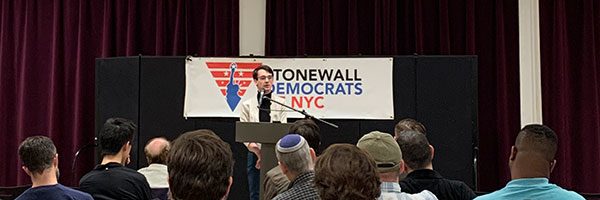
Emilia Decaudin, the author
For nearly 100 years, Democrats in the State of New York have elected one man and one woman per Assembly District to serve in the Democratic Party’s governing body, the State Committee. A rule change passed last month means that after 2020, this will no longer be the case.
Eleanor Roosevelt and the League of Women Voters pushed for gendered seats for party offices, which include State Committee, District Leader, and County Committee, in order to promote the participation of women in politics. In 2019, however, these rules mean that non-binary people—those who don’t identify as being exclusively either women or men—are, in most cases, barred from running for party office.
In order to solve this problem, I authored a resolution that passed at last month’s State Committee meeting that amends the rules of the New York Democratic Party in three important ways:
First, language that required two corresponding party officers, such as Secretary and Assistant Secretary, to be of “the opposite gender” has been changed to require they be of “different genders,” or both non-binary.
Second, language requiring gender “balance” on committee has been changed to not require members to identify as either women or men, while maintaining an equal number of the former.
Third, beginning on July 1, 2020, instead of electing “one male and one female” per Assembly District, Democrats will elect people of “different genders,” or who are both non-binary.
The resolution also adds gender and gender identity to the Party’s diversity clause and replaces gendered pronouns, such as “he or she,” with the singular “they.”
These changes will open up participation in the State Committee to a growing class of New Yorkers, while keeping in place the fundamental requirement for gender diversity that ensures that men don’t dominate party committees at the expense of women.
While this is important progress, this particular resolution only applies to the State Committee, which has no authority over the 62 County Committees in New York State. Many of those, including Brooklyn and Queens, have gendered County Committee seats, and all of them in New York City have gendered District Leader seats. These positions are arguably more important for the goal of inclusion, as most people break into the political party scene at the County Committee level.
Efforts are already underway in Manhattan and Brooklyn to remove gender requirements for District Leader and County Committee, respectively. (Manhattan doesn’t have gendered county committee seats, and Brooklyn District Leaders are coterminous with State Committee members.)
The first election for State Committee members under these new requirements will be in June of 2022. Before then, State Election Law must be changed in order to accommodate this new system. This is why I have also written a piece of legislation, sponsored by Assembly Member Richard Gottfried of Manhattan, who also sponsored the Gender Expression and Non-Discrimination Act (GENDA), in order to amend the way the Board of Elections handles elections for party positions to do just that.
The bill, which is slated to be introduced next session in Albany, changes the way all party positions for all political parties appear on the ballot. If a party has two vacancies for an office with gender requirements, instead of voting for one person in the male column and one person in the female column, voters will vote for two people in one column. Whoever gets the most votes wins one seat outright. Whoever gets the next most votes and is of the “opposite” gender or is of a different gender than the first candidate (depending on that party’s rules) also gets seated.
All of these granular changes to the way we elect candidates for party offices may seem insignificant at first. But they serve the important function of opening the door to participation by non-binary people preemptively and proactively, rather than waiting for them to knock on the door loudly and long enough for us to begrudgingly turn the lock.
Even then, there is more work to be done. Binary language that either formally or implicitly excludes non-binary people can be found in a myriad of places in our city—laws, regulations, press releases, signage, forms, and more. To tackle this issue, I’ve started Binary-Free NYC, which will serve as an umbrella for both the work being done at the party committee level and in other public forums. With any luck, New York State will continue to be a leader on gender diversity and inclusion.
****
Emilia Decaudin is a student and activist in New York City. She is the youngest and first openly transgender member of the New York State Democratic Committee, representing the 94th Assembly District in Westchester County. On Twitter @e_decaudin.
***
Have an op-ed idea or submission for Gotham Gazette? Email This email address is being protected from spambots. You need JavaScript enabled to view it.